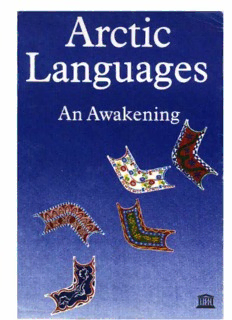
Arctic languages: an awakening PDF
Preview Arctic languages: an awakening
ARCTIC LANGUAGES An Awakening Edited by Dirmid R. F. Collis Unesco Published in 1990 by the United Nations Educational, Scientific and Cultural Organization 7, place de Fontenoy, 75700 Paris, France Printed by Imprimerie des Presses Universitaires de France, Vendome ISBN 92-3-102661-5 Unesco 1990 Printed in France The word is the greatest power human beings have. With words you can wound others or make them happy -for life. (Asineq, an East Greenlander) Preface At its eighteenth session in 1974, the General Conference of Unesco authorized the Director-General to undertake studies on Arctic cultures (Resolution 3.31) in order to promote co-operation among research insti- tutes and scholars from countries with Arctic population groups. The present publication is a part of the Unesco Arctic project aimed at safeguard- ing the non-physical heritage of Arctic peoples in its linguistic dimensions. It is the outcome of three Unesco meetings of experts, held respectively in Paris (1978), Novosibirsk (1980) and Copenhagen (1987), that worked out conceptual approaches to and practical plans for the study of Arctic cultures and languages. The work is a study of Arctic languages written in an interdisciplinary manner. Following an introduction, it goes on to deal with the concepts of the Arctic and its peoples, describing their ethnonyms and patterns of settle- ment and socio-economic structuring. General data are given on their history and traditional culture and on the system of Arctic languages. The study depicts the contemporary situation from the viewpoint of written and literary language and the legal status, social functions and uses in education and the mass media of these languages. Their role as a factor of cultural identity of the peoples is emphasized. This analysis highlights the underlying need for revitalization of Arctic languages and indicates a host of problems brought about by the impact of new socio-economic realities on traditional life and the cultural identity of the Arctic peoples. The publication is intended to foster research and draw the attention of population groups and institutions to the need to safeguard, popularize and promote the linguistic heritage of those peoples. The editor and authors are responsible for the choice and the presenta- tion of the facts contained in this book and for the opinions expressed therein, which are not necessarily those of Unesco and do not commit the Organization. The designations employed and the presentation of material throughout this publication do not imply the expression of any opinion whatsoever on the part of Unesco concerning the legal status of any country, territory, city or area or of its authorities, or concerning the delimitation of its frontiers or boundaries. Contents Dir-mid R.F. Collis General Introduction 15 I. SIBERIA: THE LANGUAGES OF THE SOVIET NORTH Il y a Gurvich Introduction 21 Chuner Taksami Ethnic Groups of the Soviet North: A General Historical and Ethnographical Description 23 Vassily Uvachan Socio-economic and Cultural Development of the Peoples of the Soviet North 39 Piotr Skorik Languages of the Soviet Northern Peoples 49 Georgy Contemporary Studies of the Eskimo-Aleut Menovshchikov Languages and Dialects: A Progress Report 69 Piotr Skorik Social Functions of the Soviet Northern Peoples’ Languages 77 Chuner Taksami Use of the Northern Languages in the Mass Media 83 Alla Bugaeva, Chuner Taksami Mother Tongues in School 93 Short Reference Guide to the Northern Languages The Manchu-Tungus Group 101 Orest Sunik, NadezhdaB ulatova Introductory Remarks 101 Vassily Robbek Even 103 Orest Sunik, Nadezhda Bulatova Evenk 104 Orest Sunik, Nadezhda Bulatova Nanai 106 Orest Sunik, NadezhdaB ulatova Negidal 107 Orest Sunik, Nadezhda Bulatova Oroki and Orochi 108 Orest Sunik, Nadezhda Bulatova Udegey 109 Orest Sunik, NadezhdaB ulatova ulchi 110 The Samoyed, Finno-Ugric (Uralic Family) and Palaeosiberian Groups 111 Nikolai Vakhtin Aleut 111 Piotr Skorik, Piotr Inenlikei Chukchi 111 Galina Grachyova Dolgan 112 Ludmila Khomich Enets 114 Georgy Menovshchikov Eskimo 114 Alexander Volodin Itelmen 116 Yevgeniya Alekseenko Ket 116 Nikolai Tereshkin Khant 117 Alevtina Zhukova Koryak 118 Yevdokiya Kuzakova, Yevdokiya Rombandeeva Mansi 119 Ludmila Khomich Nenets 120 Galina Grachyova Nganasan 122 Galina Otaina Nivkhi 122 Ludmila Khomich Sami 123 Ludmila Khomich Selkup 124 Vera D’yakonova Tofalar 124 Alevtina Zhukova Yukaghir 125 II. NORTH AMERICA AND GREENLAND: NATIVE LANGUAGES Lawrence D. Kaplan The Language of the Alaskan Inuit 131 Edna Ahgeak MacLean Culture and Change for Inupiat and Yupiks of Alaska 159 Knut Bergsland The Aleut Language of Alaska 177 Louis-Jacques Dorais The Canadian Inuit and their Language 185 Michael Fortescue The Greenlanders and their Language: Introductory Remarks 291 Robert Petersen The Greenlandic Language: Its Nature and Situation 293 Michael Fortescue Basic Structures and Processes in West Greenlandic 309 Christian Berthelsen Greenlandic in Schools 333 Inge Kleivan Debate and Linguistic Usage in Connection with Double Place-Names in Greenland 341 Christian Berthelsen Greenlandic Literature 343 Michael Fortescue A Greenlandic Tale: Alummioq, the Man from Aluk 355 Aqigssiaq Moller Language Policy and Planning under the Home Rule Administration 361 III. NORTHERN SCANDINAVIA: THE SAMI LANGUAGE: IN THE NORDIC COUNTRIES Marjut Aikio The Finnish Perspective: Language and Ethnicity 367 Elina Helander Situation of the Sami Language in Sweden 401 Ole Henrik Magga The Sami Language in Norway 419 Pekka Sammallahti The Sami Language: Past and present 4443 Illustrations Figures 1. Tungusic language family 126 2. Eskimo-Aleut language family 126 3. Chukotko-Kamchatkan language family 127 4. Na Dene language group 131 5. Syllabic and Roman orthographies 239 6. Syllabics without diacritics 240 7. Standard writing system 241 8. Language shift in the Ponku family of Vuotso between 1800 and 1982 392 Maps 1. The Soviet North 22 2. Distribution of northern peoples in USSR 25 3. Key to tribal territories 130 4. Native peoples and languages of Alaska 132 5. Distribution of Eskimo-Aleut languages and dialects in the Soviet Far East and Alaska 176 6. Inuit territory and language groups in Canada 189 7. The Greenlandic dialects 307 8. West Greenlandic 310 9. The Finnish Sami population 366 10. Administrative borders of Finnish Lapland 371 11. Language spoken by lo-year old Sami children 374
Description: